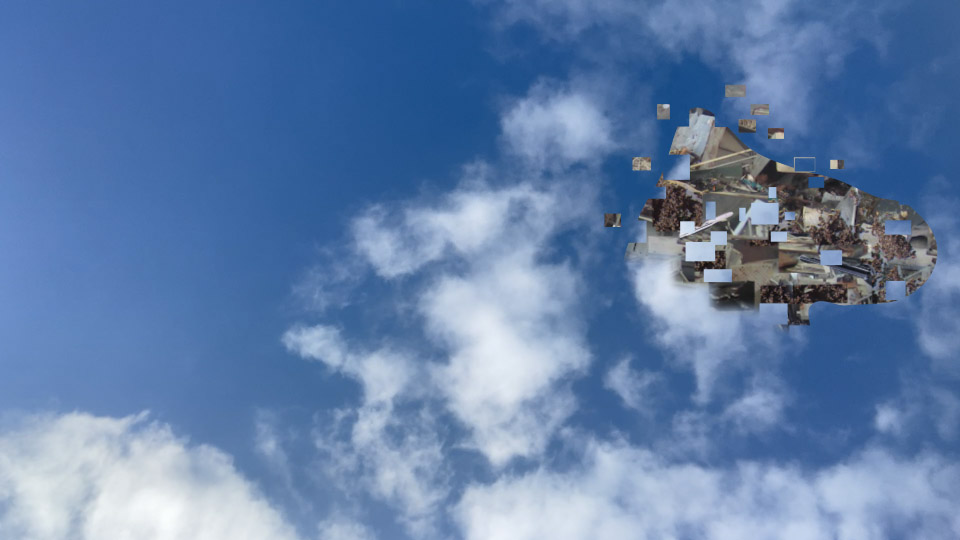Heaviness of the Cloud
Heaviness of the Cloud
(Work-in-progress/2023)
Video (A preview version)
About the project
This work-in-progress project provides web-based video artwork. The project aims to turn the ethereal metaphor of ‘the cloud’ (as in cloud computing) into the perception of the materiality of networked digital technology, its decay and the environmental degradation that the technology induces.
In the work, a series of video scenes of clouds in the sky morph the clouds into abstract moving collages that sample images related to the extractable materials used for digital technology and the environmental degradation associated with mineral material extraction.
The project makes visible the digitally induced decay and degradation that are relationally and ecologically connected to our digital devices. Further, it questions and explores how we could become sensible to the relationally connected sites of environmental degradation that are far removed from our daily perception, yet they are caused by our daily use of digital technology.
Using manually crafted pixelation methods, the artist draws on a parallel between extraction and abstraction, and develops his own artistic language of digital decay to convey the sense of how both the materiality and immaterial of digital technology are intertwined. The materiality of the decay of the ground and hardware can get entangled with the immaterial code and operationality of the relational networked technology. For instance, the grounded physical decay of e-waste and mineral mining can be made visible on the substrates of code and digital images rather than concealing such materiality. And immaterial code can have physical impacts such as carbon emissions and energy consumption.
Against the background of the ecological crisis of our time, how can art make sensible environmental degradation and how we are interdependent with the environment and others - by articulating through perception and affect, rather than through didactic communication? In response to this question, the video explores the experience of contemplation and the paradoxical dynamic slowness of sensory perception.
Developed with a grant by Arts Council England, Developing Your Creative Practice in 2023, with the mentoring support of Martin Guinard-Terrin (currently a curator at Luma Arles, previously co-curated Taipei Biennial 2020 with Eva Lin and Bruno Latour).
Further notes on the process and approaches
The artist took his smartphone outside and placed it on top of waste bins in parks in Southeast London to shoot clouds in the sky upwards. The footage was then edited to morph clouds into abstract collages that are made with the artist’s video art techniques of manually crafted pixelation to reveal materially evocative appearances: e.g. images of Critical Raw Materials minerals used for making digital devices, photographs of soil, digital devices, mining fields, and e-waste dumping ground. These images are associated with what digital technology can induce as material decay and environmental degradation, through globally connected networks of technology, resource extraction [1], supply chains, and human labour.
The pixelation is made with the artist’s intuition in a procedurally randomised, semi-improvisational way to evade patterns which existing algorithms and software could (re)produce in rationally calculated, scalable manners. This is the artist’s tribute to Anna Tsing’s (2021/de Valk, 2021) idea of the art of noticing and forging something besides the capitalist progress that the non-scalable practice on the periphery of the economy may provide.
Situated localities and specified minerals in the work (ongoing list)
Videos show different scenes of the morphing clouds. Each scene represents the above decay and degradation in relation to specific situated localities that are removed from our sight. Below is the list of the situated localities, which will be updated iteratively.
-> Agbogbloshie, Accra, Ghana

The first scene represents the situated decay of Agbogbloshie in Ghana which is one of the biggest e-waste dumping grounds in the world where informal recycling extracts copper from the waste while it harms the health of the workers and the environment.
The scene transitions into another footage piece of the sky with a network-like pixelation effect that traces the shape of submarine communication cables around Accra, which provide the Internet locally.
-> Silver Peak, Nevada, The US

Heaviness of the Cloud: Silver Peak / Lithium (Short version)
The second scene represents the Lithium mining of Silver Peak, Nevada. It is the only operating lithium mine in the US (Crawford, 2021, p29)[2]. Kate Crawford (p51) expected that the lithium would be exhausted from the land at one point and Silver Peak would become a mining ghost town.
The mining of lithium not only contributes to the environmental degradation of lands but also to the airborne pollution of battery-powered technology such as the carbon emissions associated with mobile devices, and the Internet (Crawford, 2021, pp41-42, p45/The Restart Project/Marks and de Valk, 2021).
Future updates
As the project develops further it keeps adding scenes of the decay and degradation associated with mineral extraction and situated localities.
The videos can be presented in a web version or an installation version. The web version will play the above scenes in an order determined by the (geo)location of the viewer. The installation version will be based on a ceiling projection of the video in a space.
– References –
de Valk, M. (2021) ‘A pluriverse of local worlds: A review of Computing within Limits related terminology and practices’, LIMITS Workshop on Computing within Limits [Preprint]. Available at: https://doi.org/10.21428/bf6fb269.1e37d8be.
Marks, L. and Valk, M. de (2021) On the Edge #1: Marloes de Valk, Laura Marks (Online only), On the Edge – Conversations on Sustainability in Art, Design and Media., Merz Akademie. Available at: https://www.merz-akademie.de/en/veranstaltungen/on-the-edge-1/ (Accessed: 22 January 2023).
The Restart Project (no date) ‘Mobiles: the global carbon footprint’, The Restart Project. Available at: https://therestartproject.org/the-global-footprint-of-mobiles/ (Accessed: 21 September 2023).
Tsing, A.L. (2021) The mushroom at the end of the world: on the possibility of life in capitalist ruins. New paperback printing. Princeton Oxford: Princeton University Press.
Crawford, K. (2021) Atlas of AI: power, politics, and the planetary costs of artificial intelligence. New Haven: Yale University Press.
